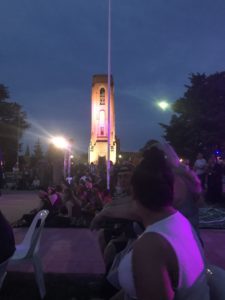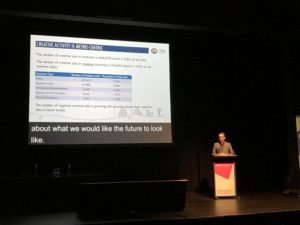
I went to Artstate and this is what I learned
This weekend saw the second year of Artstate – the NSW regional arts conference that “…is a four-year project by Regional Arts NSW to shine a light on excellence in regional arts practice and to explore the exciting possibilities for arts and cultural development across the state.” . Also “Integral to Artstate is a strong focus on Aboriginal arts and arts leaders as well as the recognition of the contribution of local government to arts and cultural development in regional NSW.”*
I went as a self-funded representative of Creatives Collective ARI inc. with several goals in mind.
- To make contacts with areas and groups that are doing great things
- To get a better understanding of what regional arts organisations are all about
- To get an understanding of how areas who have a good working relationship with their council are able to do that
- To agitate for more disabled artists and disability art to be featured at events like this
I don’t think I was successful in all areas, and that might be because of how young the event is, or that I was looking for things that just weren’t going to be covered in this year’s event. Keep in mind though, I am not from the arts’ world, nor from an arts organisation; that my lens is from our small group, in a small town, who just want to change our local area. I certainly felt like an outsider at times as everyone seemed to know everyone.
Mind you I had a great time, was enthralled and delighted by the opening ceremony, and was surprised and pleased to see NSW Minister for the Arts Don Harwin MLC attend the entire event (I bumped into him at the coffee cart and he was relaxed and chatty and obviously enjoying being there). I was also incredibly impressed with the panel that discussed The Foundations Project -the development of the former Portland Cement Works, the development of the Tremain’s Mill project in Bathurst, and how our close-ish neighbour Gularganbone utilises regular projects – like the Pave the Way to Gular project to revitalise and bring new business and visitors into their town.

It was clear from discussions I had with people that impressing on regional councils the benefits of arts and culture is a difficult task. Even with arts and culture being one of the few occupations that are guaranteed to continue into the future of robots and global warming, if a council has not ever thought beyond the farm gate or the mine entrance, you are going to have a devil of a time changing minds . It seemed that we all wanted to know how to be more appreciated (not only at local government level), seen as a necessary part of society, understood to be beneficial, both financially and health-wise. We were looking for ways to prove that we are needed (like a co-dependent partner).
This is why the keynote speech from Jack Archer, CEO, Regional Australia Institute was disappointing. We were told there’s places that are arts and culture hotspots (and surprise surprise outer suburbs of Sydney like Newcastle and Woolongong make the list) and those places are where lots of arts and culture take place, and lots of artists reside there. But I think what everyone in the audience wanted to know was how do you create those hotspots – is it a chicken and egg situation? Does a critical mass of artists naturally form in an area , or can you create an environment that attracts artists. The audience also wanted to know where’s the hard figures to be able to plonk down on a desk in local council – the figures that will magically change hide-bound thinking that local government is only about roads, rates, and rubbish. I got the impression the figures don’t exist because no-one is going to/can pay for the figures to be gathered (I am assuming there’s some kind of methodology out there to do so beyond census figures). Anyway, I think Regional Arts NSW made a good move bringing in the Regional Australia Institute because it did encourage discussion about the issue after the talk.
Speaking of methodology, there was a panel discussion by representatives from regional arts organisations that helped me understand that there’s no hard and fast set of outcomes that regional arts groups are all striving for. Some areas were well represented, had great focus on disability art, supporting their artists in creating careers and opportunities to display their art. Others were less visible. In my mind the physical manifestation of who was really working hard for their artists and areas was at the beginning of each day the opening video had a slideshow of a photo and the name of each regional arts group – and somehow it became the norm for people to cheer for their group. There were loud cheers for some areas, who obviously had a good representation of artists and arts workers. There were silence from others – sadly, Orana Arts our local area, was one of those seemingly unrepresented areas. Again was it a chicken and egg situation – does a really enthusiastic regional arts group drive great outcomes for artists, or does a group of well performing artists encourage a more enthusiastic regional arts group?

I don’t want to bore with long discussions about all of the keynotes and panels but I will say the standouts for me were the opening keynote with Jonathan Jones, I learned so much in his 30 minutes about the Aboriginal peoples of south-east Australia. I also thoroughly enjoyed the shenanigans and quite obviously caring loveliness of Ian RT Colless in the First Nations Artists: Responding to Place panel discussion.
Catching up again with Liz Martin and meeting the delightful Kerry Comerford, new CEO of Accessible Arts was a treat and I hope to spend more time discussing how we can make us disabled country artists feel like they have connection to the disabled city artists, and other exciting projects.
As for the panel I was on, “Coota’n’Coona: Small Town Solutions to Inclusive Arts Practice”, my fears of only 3 people turning up were allayed when we got a pretty good crowd. I am not sure what people got from the talk – but I think Elise Magrath, Cultural Development Officer of The Arts Centre Cootamundra made points that equated to more can be done, should be done, will be done. Our moderator, Scott Howie, ended the panel with the shout out for a disabled artist to be a keynote speaker next year and the crowd agreed.
Next year Artstate is in Tamworth, much closer to us, and maybe more of us will be able to attend.
* From the About Artstate page




